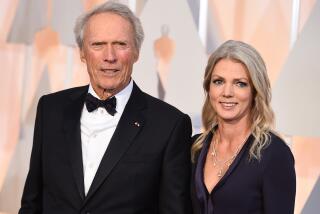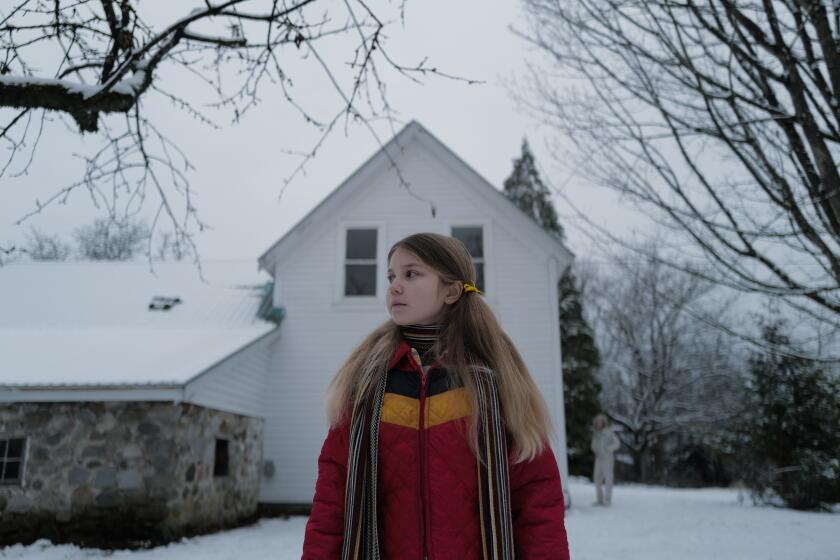Searching for Truth in Van Sant’s ‘Pink’
When River Phoenix died in 1993--of four doses of heroin and eight doses of cocaine, according to biographer John Glatt--few outside his family were more aghast than Gus Van Sant. The director, whose films are about outcasts casting about for alternative families, had formed one with Phoenix and friends in Portland in 1990 while filming “My Own Private Idaho.” The film’s title denotes “a home, a refuge,” according to Van Sant, and Phoenix phoned his Portland “home” about twice a week thereafter.
Now Van Sant, also the director of the current acclaimed film “Good Will Hunting,” has poured his searing grief over Phoenix’s OD into his bizarre first novel, “Pink.” “It was an accident,” says Van Sant, picking at a meal at Portland’s Wildwood Restaurant. He looks 10 years younger than he did on the 1992 set of “Even Cowgirls Get the Blues.” “And then you have to come back to, well, are accidents really accidents, which maybe they aren’t. I mean, I’m not sure how much inevitability there is to certain events.”
“Pink” is packed with events from Van Sant’s real life. Phoenix becomes the drug burnout Felix Arroyo, the star of narrator Spunky’s infomercials, such as “101 Useful Things You Can Do With Flamex, Made in Sasquatch, Oregon.” Felix is Latin for “happy” or “fortunate,” and an arroyo is a short-lived river in desert soil that thirsts for its certain return. Van Sant does a drawing of Felix in ghostly backlit silhouette, which is how Phoenix appears in the last footage of his unreleased last film.
The narrator, Spunky, resembles the pre-fame Van Sant, who toiled on the Pretty Feet ‘n’ Hands advertising account and hung out with the no-account independent filmmakers who showed their stuff at Portland’s Northwest Film Studies Center.
In these films, says Spunky in “Pink,” “almost everything is out of focus and the registration is unstable because of the way the film school cameraman loaded the film, so there are streaks of white like smeared halos coming off the tops of all the characters’ heads.” The 16-mm home-movie footage in “My Own Private Idaho” was shot by Phoenix, who amateurishly loaded the film wrong and produced a similar effect--a technical glitch that beautifully enhanced his character’s aura of angelic otherworldliness.
“Pink’s” character Buzz Post is a gentle swipe at Portland’s Claymation mogul Will Vinton (creator of the California Raisins), Spunky’s assistant J.D. is Van Sant’s assistant D.J., and Dewy Cyrus is Van Sant’s frequent director of photography Eric Alan Edwards. Rock couple Blackie and Blake represent Van Sant’s acquaintances Courtney Love and Kurt Cobain.
This reporter may have inadvertently sparked one episode in “Pink.” In 1995, I interviewed director Werner Herzog concerning the disparity between actual history and his historically based film “Aguirre: The Wrath of God,” just before Herzog gave a lecture at Portland’s Film Center. Van Sant saw the lecture, then led a group across the street to the Vat and Tonsure wine bar, the now-demolished capitol building of Portland bohemia. In “Pink,” Herzog becomes Todd Truelove, who sits in the bar and says, “Cinema verite is a big joke. . . . My intention when making a documentary film is to control the images in a way that allows the filmmaker to get at a more revelatory and transmissible truth.”
Van Sant’s book is all about images of truth--the tabloid truth, the deeper truths of the heart. “Slices of reality are, like, cut right into the book,” says Van Sant. But like Vladimir Nabokov, Van Sant believes the word “reality” should never appear except within sardonic quotation marks.
*
“Herzog is saying cinema verite is like trying to chase little pieces of dust through the air,” says Van Sant. “Meaning that he thinks that it’s so fruitless an objective and so, like, not about what it claims to be about, which is truth--capturing truth on film.”
Van Sant wittily points out that Herzog’s anti-cinema-verite diatribe is in itself an example of dueling realities: German vs. French. “Herzog’s, like, incensed by this French concept because he’s not French, because it’s from another, like, philosophy of film.” “Pink” is not a straight roman a clef, the fictional equivalent of cinema verite. Instead, the novelist tries to twist events into a series of “truths” more revelatory and redemptive than the excruciating reality of Phoenix writhing and bashing the sidewalk with his knuckles.
“The book is about different realities,” says Van Sant. “All the different settings in the novel are alternate realities. One of them is headed ‘Pink.Alt.Universe.’ ” But that’s not how it looks on the page. To hammer home his message about the variability of reality, Van Sant typed “Pink.Alt.Universe” in a weird typeface he found on his computer, one resembling a combination of Russian and Greek letters. The foreign-looking heading marks the chapters concerning Blake (Cobain) and his flight from the Cloudy-Bright Rehab Center.
The “Pink.Alt.Universe” chapters suggest that coming back from addiction is to live in a parallel world. The Cobain lore also comments on the existence of competing narratives about a famous event. Van Sant is an old friend of Melissa Rossi, whose book “Courtney Love: Queen of Noise: A MOST Unauthorized Biography” is the most important counter-narrative to the official version.
“The character called Blake is, a projection of me in the same position,” Van Sant says. “Because I always hear other people speculate about his suicide--from it’s not suicide to, like, oh, he was really happy, but he had just a low moment that day, to he’s been miserable for years. I’m interpreting parts of real-life experiences into this sort of more fanciful collage.”
Van Sant admits to being under the influence of the collage style of the film “Slaughterhouse Five” (he never read the novel) and the quasi-memoirs of Jack Kerouac, who gave his friends different names in his novels--he called them “funny hats.” But “Pink’s” main influence is Joseph Heller’s dolefully unfunny comic midlife-crisis novel “Something Happened.” “That’s a big book for me,” says Van Sant. “It’s an investigation of starting with this character’s home life to his inner mind to his past.” Heller’s hero is haunted by the memory of his son, whom he accidentally smothered to death while hugging the boy after he’d been hit by a car.
Van Sant is most haunted by Phoenix. He is also clearly outraged that many people blame his death spiral on Van Sant, on the theory that Phoenix’s drug use accelerated after he got into character for his “My Own Private Idaho” role. They depict Van Sant as a cold-hearted exploiter like Andy Warhol who, vampire-like, fed on his stars’ reckless behavior on camera. This seems an unlikely comparison, given Van Sant’s evident emotional ties with the Phoenix family--and the fact that Joaquin Phoenix, the brother who was with River when he died, chose to star in Van Sant’s comeback film, “To Die For.”
In “Pink,” Van Sant skewers the reporters who climb trees in the narrator’s yard, point telephoto lenses at his windows and demand, “What really went on during the notorious shooting of the infomercial ‘101 Useful Things You Can Do With Flamex’?” The narrator complains, “They began to make up the story for themselves, unsatisfied with the statements that I made.”
“A lot of time it comes from, like, informers,” says Van Sant, targeting the gossip mongers. “It’s like the story about [the famous actor] and the hamster in the hospital. All these different people who knew the nurse, it was always . . . ‘Well, I know somebody who knew the nurses.’ But you could never actually find The Nurse. So then it just becomes part of The Story.”
While Phoenix did not take the fatal doses while crafting his masterpiece role with Van Sant, some would say his death suggests that there is an element of denial in Van Sant’s narrative. Van Sant was quoted in Monk magazine after Phoenix’s death as saying, “I don’t think he had a drug habit. . . . To the bitter end, I assumed that it wasn’t drug-related.”
Yet denial is an aspect of grief, and the novel is in part a desperate imaginative effort to come up with a palliative reality. “The entire character’s foundation is that he’s completely misconstruing pretty much everything from the very beginning,” says the author. “His explanation of what was really going on was kind of based on, um, sometimes me--I mean, ultimately it’s me. I always get stuff wrong, just in general. It seems to me like everybody is always getting something wrong. There’s no real--nobody’s getting at the truth.”
Van Sant takes this argument all the way. “Basically, there’s ultimately not really a particular reality at all. Like, if you drop the knife it will, like, land on the ground. These are very sort of logical things that we’ve learned to make logical because we live in this particular universe. Perhaps on other, in other dimensions, things falling to the ground might just seem fantastic, you know--just might seem as fantastic as things flying into the sky.”
Van Sant’s novel invents an alternative to a cold world where young, beloved men can drop dead on a Sunset sidewalk: the world called “Pink.” Says Van Sant, “It’s the name of a sort of other dimension wherein we go when we die, so it’s a lighter word for death.”
In his book, pink is the color film turns when it fades and decays, and then “destroyed cruelly like drowning a little puppy after you are tired of playing with it.” Though Van Sant doesn’t specify pink’s association with gay sex, he includes matter-of-fact sex scenes and drawings, as if in answer to the impertinent questions Phoenix used to pester him with on set; Phoenix wanted to know precisely what Van Sant did with his boyfriend in bed.
The answer, along with a lot of others, is in “Pink,” concealed behind the skimpiest scrim of fiction. Pink is a posthumous love letter to Phoenix--a platonic one.
But if you ask Van Sant what a reader might learn about him from reading his novel, he replies, “Oh, I don’t think there really is [he clears his throat] that sort of relationship. I’m not sure it’s really, like, it’s not really about the real me. You know?”
More to Read
Only good movies
Get the Indie Focus newsletter, Mark Olsen's weekly guide to the world of cinema.
You may occasionally receive promotional content from the Los Angeles Times.






